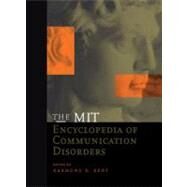The Mit Encyclopedia of Communication Disorders
, by Raymond D. Kent (Ed.)- ISBN: 9780262112789 | 0262112787
- Cover: Hardcover
- Copyright: 10/1/2003
A massive reference work on the scale of MITECS (The MIT Encyclopedia of Cognitive Sciences), The MIT Encyclopedia of Communication Disorderswill become the standard reference in this field for both research and clinical use. It offers almost 200 detailed entries, covering the entire range of communication and speech disorders in children and adults, from basic science to clinical diagnosis. MITECDis divided into four sections that reflect the standard categories within the field (also known as speech-language pathology and audiology): Voice, Speech, Language, and Hearing. Within each category, entries are organized into three subsections: Basic Science, Disorders, and Clinical Management. Basic Science includes relevant information on normal anatomy and physiology, physics, psychology and psychophysics, and linguistics; this provides a scientific foundation for entries in the other subsections. The entries that appear under Disorders offer information on the definition and characterization of specific disorders, and tools for their identification and assessment. The Clinical Management subsection describes appropriate interventions, including behavioral, pharmacological, surgical, and prosthetic. Because the approach to communication disorders can be quite different for children and adults, many topics include separate entries reflecting this. Although some disorders that are first diagnosed in childhood may persist in some form throughout adulthood, many disorders can have an onset in either childhood or adulthood, and the timing of onset can have many implications for both assessment and intervention. Topics covered in MITECDinclude cochlear implants for children and adults, pitch perception, tinnitus, alaryngeal voice and speech rehabilitation, neural mechanisms of vocalization, holistic voice therapy techniques, computer-based approaches to children?s speech and language disorders, neurogenic mutism, regional dialect, agrammatism, global aphasia, and psychosocial problems associated with communicative disorders.







